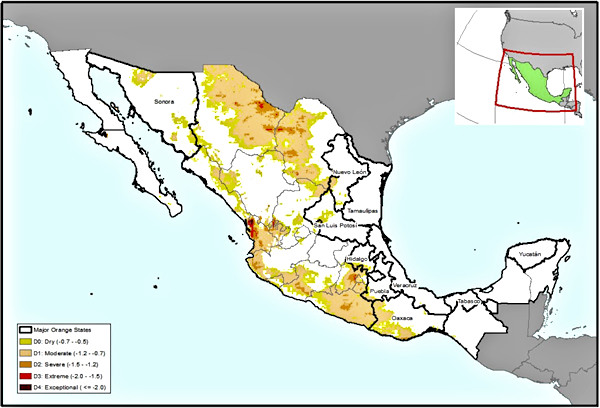Many of Mexico's citrus-growing areas are suffering significant, unrelenting drought. That's led to a decrease in total citrus production compared to last year. Orange yields are expected to drop by 45%. This meager orange supply for processing affects exports. These exports are of fresh, concentrated orange juice to the United States. This will fall by almost half the 2018/2019 export level. Huanglongbing Citrus greening disease (HLB) is also a threat to Mexican citrus farmers.
 The yellow shading indicates Mexico's drought areas (dated 25 May 2020)
The yellow shading indicates Mexico's drought areas (dated 25 May 2020)
Drought and high temperatures
Orange production is estimated at 2,53 million tons for 2019/2020. That's 45% less than previous estimates. It's also the lowest expected harvest since the early 90s. This estimate is based on grower data and discussions with sector representatives.
The persistent drought and high temperatures have had a more drastic effect on orange production that other citrus. That's because many of the orange groves are older and meed more energy to produce fruit. Many small farmers also lack irrigation technology. They practice bad pest control too, which compounds cultivation issues. Large-scale growers mostly have several irrigation mechanisms. They use fertilizers and apply other mitigating measures too. These include leaving weeds growing around the tree trunks. This retains moisture.
There have been intense temperatures and lack of rain throughout the growing season. That's resulted in a wide-spread decline in the orange's quality. Most fruit in the orange-growing region are smaller and of lower quality. In the state of Veracruz, October and November 2019 were the hottest months.
It usually rains throughout the growing season. However, this season, it was concentrated in two months. That resulted in a shorter growing season. The last flowering cycle indicates the harvest's end. This was between December and March. In Veracruz, oranges can usually be harvested until June.
Revitalizing the orange groves
The drought and sweltering temperatures have, no doubt, affected production in 2019/2020. But many growers consider the changing weather patterns as the 'new normal'. Farmers are revitalizing orchards, adding irrigation systems, and planting new trees. They do, however, understand it will be difficult to recover production and yields.
Governmental support is sorely needed to renew infrastructure and revitalize orchards. There are also concerns that - without the government's help - citrus greening will become a more serious problem across the country. That will bring production down even more.
HLB
Mexican citrus is being plagued by Huanglongbing Citrus greening disease (HLB). This disease causes citrus trees to bear misshapen, partially green fruit. Their taste isn't generally affected. But these fruits can't be sold for fresh consumption. HLB was first discovered in Mexico in 2009.
Since then, the government's implemented a disease monitoring program. HLB has been detected in all of Mexico's citrus-growing areas. These include places like Veracruz, Tamaulipas, San Luis Potosi, and Nuevo Leon. In 2019, HLB was detected in Baja California, in the border region between California and Mexico.
For more information: Mexico Citrus Update/USDA
